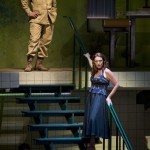By: Edna Landau
To ask a question, please write Ask Edna.
To Our Readers:
I hope you have all had a very enjoyable summer and I welcome you back to Ask Edna. Since a number of our readers have moved over the summer, I have decided to dedicate this first column of the new season to a question that was posed to me at a session I did at the Imani Winds Chamber Music Festival in July. I was asked how someone who is well-established as a musician in a particular city can make connections when they move to a new city where they don’t know anyone. In thinking about this, I chose to contact pianist Makiko Hirata, a graduate of the Colburn School and now a doctoral candidate at The Shepherd School of Music/Rice University. I have always found her to be very entrepreneurial so I was curious as to how she had personally approached this.
Makiko told me that before moving to Houston, her teacher in Los Angeles called several faculty members at the Shepherd School to introduce her. A prominent composer whose work she had recorded called a number of composers and musicians in the Houston area to introduce her as well. Upon arrival in Houston, Makiko got in touch with some members of the Japanese consulate there, as she had been advised to do by some contacts in the Japanese-American community in Los Angeles. She also auditioned for and was accepted into the Young Artist Program of the Da Camera Society, which provided her with performance opportunities ranging from in-school concerts to a fundraising event where former president George H. W. Bush and Barbara Bush were in the audience. On her own, Makiko organized a fundraiser following the devastating tsunami/earthquake that happened in her native Japan. She got tremendous support from the administration at Rice University, the faculty at the Shepherd School of Music, the media, the local community, and the Japanese community in the greater Houston area. In the end, she raised over $10,000 and (in her words) “found a supportive community of music lovers that was eager to learn about and support her activities and dreams.”
Here are some more things you might want to try, depending on your career objectives:
- Check online to see if there is an arts council in your new location. They will often list performance opportunities as well as events taking place in the area.
- Learn about any established concert series in your new home city. (Check Musical America’s listings!) Take a look at their website and read their newsletter. Try to attend at least one concert and meet the presenter afterwards.
- Much of the musical activity in any town revolves around the school and its music department. Many such concerts are free. Make a point of going to one or two of them and saying hello to the performers afterwards.
- Find out who the contractor is for any local orchestra, festival or special occasion gigs, such as weddings.
- Acquaint yourself with the venues that are currently being used for concerts and explore new possibilities such as churches, synagogues, banks, galleries, book stores, meeting halls, museums, and even the local zoo. Consider doing a benefit concert for a local charity.
- Learn about schools, hospitals, retirement homes and social service organizations who might welcome the opportunity to offer musical programs.
- If there is a local classical music station, see if they would be interested in live performances.
- If you are seeking chamber music partners and are not a student, place an ad in an appropriate local publication. The same would apply if you are interested in teaching or playing wedding jobs.
- Network with people who are already established in the community, such as teachers, to see who they think it might be worth your while to meet. Try to include people who aren’t necessarily musicians.
- Investigate whether there are any conductors for whom you might audition.
- Check out opportunities in nearby cities within commuting distance, especially if you hope to play in an orchestra.
Any number of these roads should lead you to individuals who can give you valuable advice about how to be most productive and successful in your new home town.
To ask a question, please write Ask Edna.
© Edna Landau 2012



